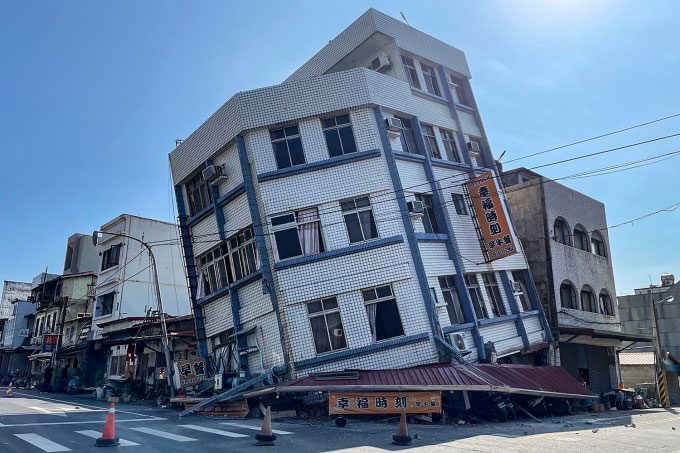Located on the Pacific Ring of Fire and frequently experiencing earthquakes, Taiwan has meticulously prepared to respond to this type of natural disaster.
On April 3, Taiwan was hit by a 7.4 magnitude earthquake, the strongest in 25 years. At least 9 people have died, and hundreds have been injured. Buildings and roads were damaged, and dozens of workers in quarries were trapped. Experts indicate that strong earthquakes are not uncommon in Taiwan, but the damage incurred by the island’s 23 million residents is relatively limited due to good preparation.

A building at the intersection of North Tien and Khang Lac streets, Hualien County, tilted to one side and lost its first floor. (Photo: AFP).
The assessment shows that this relatively low level of damage contrasts sharply with the devastation caused by strong earthquakes in many other areas.
In 2011, an earthquake in Christchurch, New Zealand, resulted in 165 deaths. The earthquake in Nepal in 2015 killed nearly 10,000 people. The earthquake disaster in Pakistan in 2005 claimed nearly 90,000 lives, and the 2010 earthquake that struck the island of Hispaniola resulted in the deaths of 300,000 Haitians.
“Taiwan’s earthquake preparedness is among the most advanced in the world. The island has implemented strict building regulations, deployed advanced seismic networks, and conducted extensive community education campaigns on earthquake safety,” said seismologist Stephen Gao, a professor at the Missouri University of Science and Technology.
Images and videos show buildings leaning in Hualien, eastern Taiwan. Structures are leaning into the streets, surrounded by a few fallen bricks and stones, yet remain quite intact, while cranes and rescue workers navigate around them. In some cases, air conditioning units are still mounted on windows, and many windows remain unbroken.
This case could be “soft-story collapse,” according to Christie Rowe, an earthquake geology expert at McGill University, Canada. “This is one of the most common types of structural damage in earthquakes and often results in total loss of the structure,” Rowe shared with the National Post.
Taiwan restricted soft-story design following the 1999 earthquake disaster, but these may be older buildings without reinforced lower floors. However, because the remaining structure of the building is sufficiently robust, even when a soft-story collapse occurs, the frame of the house remains intact. A steel frame building, even with the ground floor collapsed, may still be sturdy enough to stand almost upright. Meanwhile, Rowe noted that buildings made of brick or stone would be completely destroyed.
Taipei 101, the tallest building in Taiwan, stood firm during the 7.4 magnitude earthquake on April 3. (Video: X)
There are three factors that determine the level of damage in an earthquake, according to Rowe.
- First is seismic intensity – the level of energy released by the earthquake. The 2010 earthquake in Haiti had an intensity of 7.0 while the earthquake in Taiwan on April 3 was 7.4, and the earthquake in Nepal was 7.8.
- Second is geology. “The impact from location on the level of damage can be equally significant, if not more so,” Rowe noted. For example, if built on solid rock, a city will suffer less damage during an earthquake. Seismic waves passing through the ground after an earthquake will have a smaller amplitude in solid rock compared to in saturated soil, meaning the shaking that affects a building on the surface will be lighter.
- Third is construction methods. Modern, advanced buildings are more likely to remain standing during an earthquake. They can bend flexibly but are less likely to topple over.
Many countries have established building codes to ensure new buildings can withstand earthquakes. However, many older buildings have not been retrofitted or improved. Taiwan, located in an earthquake-prone area, has incorporated anti-earthquake regulations into its building codes since 1974. These regulations have also been updated and reinforced multiple times since then (other regulations existed prior to 1974).
“Taiwan has had very high building standards for a very long time,” Rowe stated. He noted that although earthquakes have caused damage in Taiwan in the past, the extent of that damage pales in comparison to what other countries would suffer in the same earthquake.
In addition, Taiwan has developed an advanced earthquake warning system, and the people have “an incredible understanding of earthquake preparedness.” “They know what to do, they know how to help each other. Everyone is prepared, from what to do at home to at school, in the city, and in large-scale infrastructure, everything is coordinated quite closely,” Rowe said.
Why does Taiwan experience so many earthquakes?

The Pacific Ring of Fire, an area frequently affected by earthquakes. (Photo: Universal Images Group Editorial).
Taiwan is situated along the Pacific Ring of Fire, a seismic fault line encircling the Pacific Ocean, where most of the world’s earthquakes occur, according to the Washington Post. This area is particularly prone to tremors due to stress accumulation from the interaction between the Philippine and Eurasian tectonic plates, which can lead to sudden releases in the form of earthquakes.
The fault in the Taiwan earthquake is a reverse fault, meaning one side of the fault moves up over the other. Under the ocean, water is displaced significantly, potentially causing tsunamis.
Taiwan’s mountainous landscape can amplify ground shaking, leading to landslides. Some of these landslides occurred along the eastern coast of Taiwan, near the epicenter of the April 3 earthquake, close to eastern Hualien County. Rocks and soil fell onto tunnels and highways, crushing vehicles and causing some fatalities.





















































